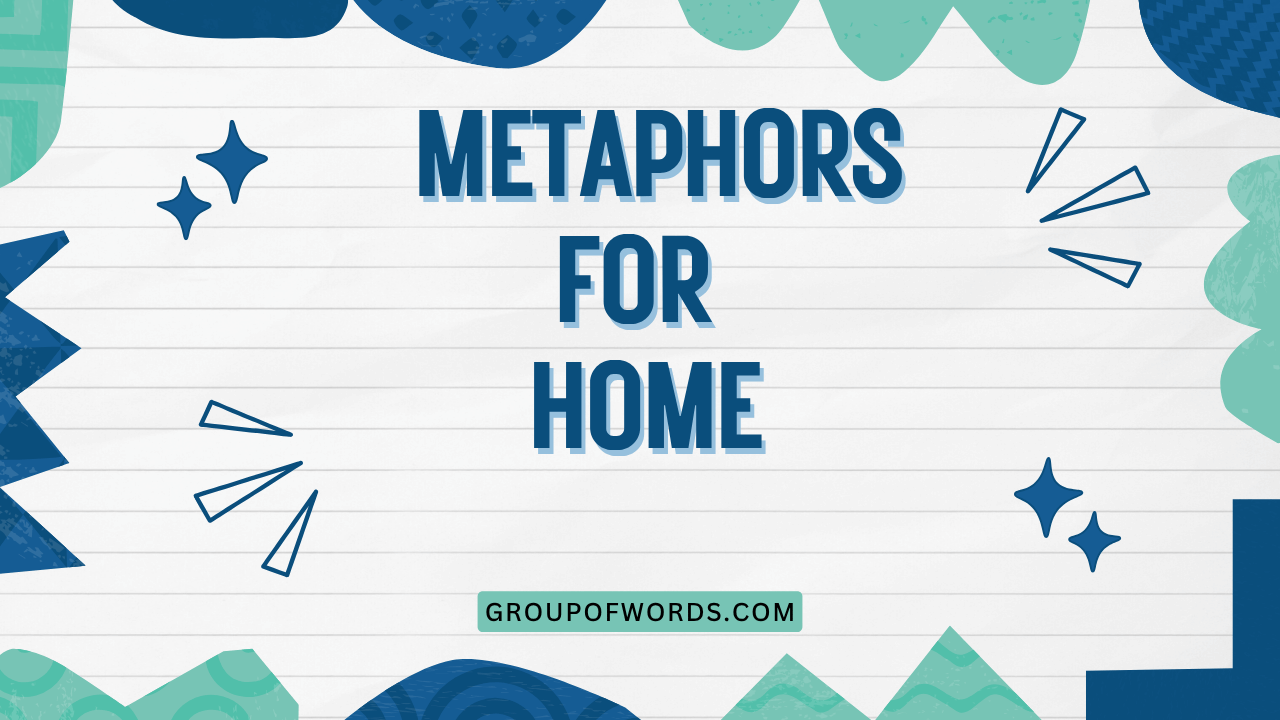Home as a Haven: Exploring Metaphors in English
Metaphors are powerful tools in the English language, allowing us to understand abstract concepts by relating them to concrete experiences. The concept of “home” is particularly rich with metaphorical potential, as it evokes deep emotions and personal associations.
Understanding these metaphors can greatly enhance your comprehension of literature, poetry, and everyday conversation. This article will explore the various ways home is used metaphorically, providing a comprehensive guide for English language learners of all levels.
Table of Contents
- Introduction
- Defining Metaphors for Home
- Structural Breakdown of Home Metaphors
- Types and Categories of Home Metaphors
- Examples of Home Metaphors
- Usage Rules for Home Metaphors
- Common Mistakes with Home Metaphors
- Practice Exercises
- Advanced Topics in Home Metaphors
- Frequently Asked Questions
- Conclusion
Defining Metaphors for Home
A metaphor is a figure of speech that directly compares two unrelated things without using “like” or “as.” It asserts that one thing *is* another, creating a vivid and often surprising connection. When we use metaphors for “home,” we’re not just talking about a physical building; we’re using the idea of home to represent something else entirely, such as safety, belonging, or even a state of mind.
The function of a metaphor for home is to enrich our understanding and evoke emotional resonance. By associating home with abstract concepts, we make those concepts more relatable and understandable.
These metaphors appear frequently in literature, poetry, songs, and everyday speech, adding depth and nuance to our communication.
Home metaphors are particularly powerful because the concept of “home” is deeply personal and culturally significant. What constitutes “home” varies greatly from person to person, making the metaphorical possibilities endless.
Understanding the nuances of these metaphors allows for a more profound appreciation of the English language and the human experience.
Structural Breakdown of Home Metaphors
The structure of a home metaphor typically involves two key elements: the tenor and the vehicle. The tenor is the subject being described, while the vehicle is the concept used to describe it – in this case, some aspect of ‘home’. For example, in the metaphor “Her heart was her home,” the tenor is “her heart,” and the vehicle is “home.” The metaphor suggests that her heart provides safety, comfort, and belonging, just like a physical home.
The effectiveness of a metaphor depends on the strength of the connection between the tenor and the vehicle. A strong metaphor creates a clear and resonant association, while a weak metaphor may be confusing or unconvincing.
Identifying the tenor and vehicle is crucial for understanding the meaning and impact of a home metaphor.
Consider the sentence, “His job was his home.” Here, the tenor is “his job,” and the vehicle is “home.” This implies that his job provides him with stability, purpose, and perhaps even a sense of family. The structure is simple, yet the meaning is layered and evocative.
Types and Categories of Home Metaphors
Home as Shelter
This is one of the most common types of home metaphors. Home is portrayed as a place of safety, security, and protection from the outside world.
It’s a refuge from storms, both literal and figurative.
Home as Identity
In this category, home is linked to one’s sense of self. It represents where you come from, your roots, and your personal history.
It shapes who you are and provides a sense of belonging.
Home as an Emotional State
Here, home is not a physical place but rather a feeling of comfort, peace, and contentment. It’s an internal state of being that can be found anywhere, regardless of location.
Home as a Person
This type of metaphor equates a person to home, suggesting that they provide the same feelings of safety, comfort, and belonging as a physical home. This is often used to describe close family members or romantic partners.
Home as a Journey
In this metaphor, the search for home becomes a journey, either physical or emotional. It represents the quest for belonging, self-discovery, and finding one’s place in the world.
Examples of Home Metaphors
The following tables provide a variety of examples of home metaphors, categorized by the types discussed above. Each example illustrates how the concept of home is used to convey different meanings and emotions.
Home as Shelter Examples
This table displays examples of how ‘home’ is used metaphorically to represent ‘shelter’ or a place of safety and protection.
| Metaphor | Explanation |
|---|---|
| His arms were her home during the storm. | His embrace provided her with safety and comfort during a difficult time. |
| The library was a home for his thoughts. | The library offered a safe and quiet space for him to explore his ideas. |
| Her music became a home for her anxieties. | Creating music allowed her to process and find refuge from her anxieties. |
| The old oak tree was a home for the birds. | The tree provided shelter and protection for the birds. |
| His faith was his home in times of trouble. | His faith offered him comfort and security when he faced difficulties. |
| The small cafe was a home to the lonely souls in the city. | The cafe provided a welcoming and comforting space for people who felt alone. |
| Books were her home, shielding her from the harsh realities of the world. | Reading offered her an escape and a sense of safety from difficult situations. |
| Friendship was a home where they could always be themselves. | Their friendship provided a safe and accepting environment for them to be authentic. |
| The artist’s studio was a home for creativity. | The studio provided a space where the artist felt safe and inspired to create. |
| Meditation became a home for her restless mind. | Meditation offered her a way to find peace and calm within herself. |
| The theater was a home for his dramatic spirit. | The theater provided a space where he could express himself freely and safely. |
| Her garden was a home for her worries. | Gardening allowed her to work through her worries and find peace in nature. |
| The classroom was a home for eager minds. | The classroom provided a safe and stimulating environment for learning. |
| His journal was a home for his secret thoughts. | His journal provided a private space where he could express his innermost thoughts and feelings. |
| The forest was a home for the wandering deer. | The forest provided a natural habitat where the deer could find shelter and safety. |
| Her art was a home, protecting her from self-doubt. | Creating art gave her confidence and shielded her from negative self-perception. |
| The church was a home for the community, offering support and solace. | The church provided a place where people could gather, find comfort, and receive assistance. |
| Volunteering became a home for her desire to help others. | Volunteering provided her with a fulfilling way to contribute to society and make a difference. |
| The mountain was a home for his adventurous soul. | Climbing the mountain satisfied his need for challenge and provided a sense of accomplishment. |
| Yoga was a home for her stressed body. | Practicing yoga allowed her to relax her body, relieve tension, and find inner peace. |
| The quiet corner of the library was a home for his introverted spirit. | The library provided a safe and quiet space where he could recharge and feel comfortable. |
| Her writing was a home, sheltering her from the criticisms of the world. | Writing allowed her to express herself freely without fear of judgment. |
| The dance studio was a home for her expressive movements. | Dancing provided her with a space where she could move freely and express her emotions. |
| His motorcycle was a home on the open road, offering freedom and escape. | Riding his motorcycle allowed him to feel liberated and disconnect from his daily worries. |
Home as Identity Examples
This table showcases instances where ‘home’ is used to represent one’s identity, roots, or sense of belonging.
| Metaphor | Explanation |
|---|---|
| Her family was her home. | Her family provided her with a sense of belonging and identity. |
| His hometown was his home, no matter where he traveled. | His hometown represented his roots and shaped his sense of self. |
| Culture was her home, shaping her values and beliefs. | Her cultural background was integral to her identity. |
| Their shared history was their home, binding them together. | Their collective experiences created a strong sense of connection and identity. |
| The language was her home, connecting her to her ancestors. | Speaking her native language connected her to her heritage and sense of belonging. |
| His music was his home, a reflection of his soul. | His music expressed his deepest feelings and defined his artistic identity. |
| The community was her home, providing support and camaraderie. | Her community offered a sense of belonging and shared identity. |
| Her heritage was her home, a source of pride and strength. | Her cultural background gave her a sense of identity and resilience. |
| His values were his home, guiding his actions and decisions. | His moral principles defined his character and shaped his behavior. |
| The tradition was their home, passed down through generations. | Their customs and rituals connected them to their ancestors and their shared identity. |
| Her art was her home, expressing her unique perspective. | Her artistic creations reflected her individuality and her way of seeing the world. |
| His memories were his home, preserving his past experiences. | His recollections of past events shaped his understanding of himself and his history. |
| The land was their home, providing sustenance and connection. | Their connection to the natural environment defined their way of life and their identity. |
| Her beliefs were her home, giving her purpose and direction. | Her convictions provided her with a sense of meaning and guided her choices. |
| His passion was his home, driving his actions and ambitions. | His enthusiasm and dedication fueled his pursuits and shaped his identity. |
| Her name was her home, representing her lineage and identity. | Her family name connected her to her ancestors and her cultural heritage. |
| Their shared values were their home, uniting them in purpose. | Their common principles created a strong bond and a shared sense of identity. |
| His profession was his home, defining his role in society. | His career gave him a sense of purpose and shaped his social identity. |
| Her faith was her home, offering comfort and guidance. | Her religious beliefs provided her with a sense of belonging and spiritual identity. |
| His principles were his home, guiding his ethical choices. | His moral standards shaped his behavior and his sense of integrity. |
| The organization was her home, uniting them in a common cause. | Her involvement in the organization gave her a sense of purpose and shared identity. |
| His community was his home, providing support and belonging. | His local connections gave him a sense of place and a shared identity. |
| The school was her home, shaping her intellect and character. | Her education molded her mind and helped her develop her personal identity. |
| His travels were his home, broadening his horizons and experiences. | His adventures shaped his worldview and his sense of self. |
| Her writing was her home, allowing her to express her unique voice. | Her literary creations reflected her individuality and her personal identity. |
Home as an Emotional State Examples
This table provides examples that use ‘home’ to represent an internal emotional state, such as comfort, peace, or contentment.
| Metaphor | Explanation |
|---|---|
| Peace was her home. | She found a sense of inner peace and tranquility. |
| Happiness was his home. | He was consistently joyful and content. |
| Contentment was their home. | They lived a life of satisfaction and fulfillment. |
| Solitude was her home. | She found comfort and peace in being alone. |
| Joy was his home, radiating from within. | He exuded happiness and positivity. |
| Serenity was her home, a constant state of mind. | She maintained a calm and peaceful disposition. |
| Gratitude was his home, shaping his perspective. | He focused on the positive aspects of his life and was thankful for what he had. |
| Love was their home, a foundation of their relationship. | Their relationship was built on a strong foundation of love and affection. |
| Optimism was her home, guiding her through challenges. | She faced difficulties with a positive outlook and a belief in a favorable outcome. |
| Kindness was his home, influencing his actions. | He treated others with compassion and generosity. |
| Empathy was her home, connecting her to others. | She understood and shared the feelings of others. |
| Forgiveness was his home, releasing him from resentment. | He let go of past hurts and moved forward with compassion. |
| Hope was her home, sustaining her through adversity. | She maintained a positive outlook and a belief in a better future. |
| Patience was his home, allowing him to persevere. | He remained calm and composed in difficult situations. |
| Acceptance was her home, embracing her imperfections. | She acknowledged her flaws and embraced herself fully. |
| Courage was his home, empowering him to face his fears. | He confronted challenges with bravery and determination. |
| Resilience was her home, enabling her to bounce back from setbacks. | She recovered quickly from difficulties and learned from her experiences. |
| Peacefulness was his home, a refuge from the world’s chaos. | He found inner tranquility and serenity. |
| Understanding was her home, bridging differences between people. | She sought to comprehend others’ perspectives and promote harmony. |
| Compassion was his home, driving him to help those in need. | He felt empathy for others and acted to alleviate their suffering. |
| Balance was her home, integrating different aspects of her life. | She maintained equilibrium and harmony in her personal and professional life. |
| Mindfulness was his home, allowing him to appreciate the present moment. | He focused on the here and now and savored each experience. |
| Simplicity was her home, decluttering her life and mind. | She embraced minimalism and focused on what truly mattered. |
| Creativity was his home, inspiring him to innovate and explore. | He expressed his imagination and ingenuity through various outlets. |
| Authenticity was her home, living true to her values. | She acted in accordance with her beliefs and remained genuine. |
Home as a Person Examples
The following examples demonstrate how a person can be metaphorically described as ‘home’, suggesting they provide similar feelings of comfort and security.
| Metaphor | Explanation |
|---|---|
| She was his home. | She provided him with comfort, love, and a sense of belonging. |
| He was her home, a safe harbor in a storm. | He offered her protection and security during difficult times. |
| They were each other’s home. | They found comfort, support, and belonging in their relationship. |
| Her grandmother was her home, full of warmth and love. | Her grandmother provided her with a sense of security and unconditional love. |
| His best friend was his home, always there to listen and understand. | His best friend offered him support, empathy, and a sense of connection. |
| Her mentor was her home, guiding her through challenges. | Her mentor provided her with wisdom, support, and encouragement. |
| His children were his home, filling his life with joy and purpose. | His children gave him a sense of fulfillment and meaning. |
| Her partner was her home, a constant source of strength and support. | Her partner provided her with stability, love, and encouragement. |
| His sibling was his home, a lifelong bond of shared experiences. | His sibling offered him companionship, understanding, and a sense of shared history. |
| Her teacher was her home, inspiring her to learn and grow. | Her teacher motivated her to pursue knowledge and develop her potential. |
| His coach was his home, pushing him to achieve his goals. | His coach challenged him to excel and provided guidance and support. |
| Her therapist was her home, helping her heal and find peace. | Her therapist assisted her in processing her emotions and finding inner peace. |
| His community leader was his home, uniting them in a common cause. | His community leader inspired him to work towards a shared goal. |
| Her spiritual guide was her home, offering her wisdom and direction. | Her spiritual leader provided her with guidance and insight. |
| His role model was his home, inspiring him to be his best self. | His role model motivated him to emulate their admirable qualities. |
| Her pet was her home, offering unconditional love and companionship. | Her pet provided her with affection, comfort, and a sense of connection. |
| His fellow veterans were his home, sharing a bond of service. | His fellow veterans offered him camaraderie, understanding, and support. |
| Her fellow artists were her home, inspiring her creativity. | Her fellow artists provided her with inspiration, encouragement, and a sense of community. |
| His teammates were his home, working together towards a common goal. | His teammates offered him support, encouragement, and a sense of shared purpose. |
| Her fellow activists were her home, fighting for a better world. | Her fellow activists provided her with inspiration, support, and a sense of shared mission. |
| His fellow students were his home, learning and growing together. | His fellow students offered him camaraderie, support, and a shared learning experience. |
| Her fellow volunteers were her home, giving back to the community. | Her fellow volunteers provided her with inspiration, support, and a sense of shared purpose. |
| His fellow musicians were his home, creating beautiful music together. | His fellow musicians offered him inspiration, support, and a shared artistic experience. |
| Her fellow writers were her home, sharing their stories and experiences. | Her fellow writers provided her with inspiration, support, and a sense of community. |
| His fellow travelers were his home, exploring the world together. | His fellow travelers offered him companionship, adventure, and shared experiences. |
Usage Rules for Home Metaphors
While metaphors offer creative freedom, it’s important to use them effectively. Here are some rules to keep in mind:
- Clarity: Ensure the connection between the tenor and vehicle is clear. The metaphor should enhance understanding, not confuse it.
- Relevance: The metaphor should be relevant to the context. A poorly chosen metaphor can feel out of place and detract from the message.
- Originality: While common metaphors can be effective, strive for originality to make your writing more engaging. Avoid clichés.
- Consistency: Maintain consistency within the metaphor. Don’t mix metaphors in a way that creates a confusing or contradictory image.
- Audience: Consider your audience when choosing metaphors. A metaphor that resonates with one audience may not work for another.
Common Mistakes with Home Metaphors
One common mistake is using clichéd or overused metaphors. For example, saying “Home is where the heart is” is technically correct, but it lacks originality and impact.
Another mistake is creating mixed metaphors, where the comparison becomes confusing. For instance, “His job was his home, but it was also a sinking ship” mixes two incompatible images (home and sinking ship), creating a nonsensical comparison.
Correct: Her art was her home, a sanctuary of creativity.
Incorrect: Her art was her home, a rollercoaster of emotions.
Correct: He found home in her laughter.
Incorrect: He found home in her laughter, a stormy sea of feelings.
The incorrect examples create confusing or contradictory images, weakening the intended message. Always ensure your metaphors are clear, relevant, and consistent.
Practice Exercises
These exercises will help you practice identifying and using home metaphors effectively. Each question requires you to either identify the metaphor, explain its meaning, or create your own metaphor using “home.”
| Question | Answer |
|---|---|
| 1. Identify the metaphor: “Her garden was her home.” | The metaphor is “Her garden was her home.” |
| 2. Explain the meaning of: “His memories were his home.” | His memories provided him with a sense of comfort, identity, and connection to the past. |
| 3. Create a metaphor using “home” to describe friendship. | Friendship is a home where you can always be yourself. |
| 4. Identify the metaphor: “He found home in the rhythm of the waves.” | The metaphor is “He found home in the rhythm of the waves.” |
| 5. Explain the meaning of: “Her faith was her home during difficult times.” | Her faith provided her with comfort, strength, and a sense of security during challenging moments. |
| 6. Create a metaphor using “home” to describe a good book. | A good book is a home for the imagination. |
| 7. Identify the metaphor: “Their love was their home.” | The metaphor is “Their love was their home.” |
| 8. Explain the meaning of: “His music was his home, a place of expression and release.” | His music provided him with a space where he could freely express his emotions and find creative fulfillment. |
| 9. Create a metaphor using “home” to describe a favorite hobby. | My hobby is a home where I can relax and recharge. |
| 10. Identify the metaphor: “Her laughter was his home.” | The metaphor is “Her laughter was his home.” |
| 11. Explain the meaning of: “The stage was her home, where she truly belonged.” | The stage was the place where she felt most comfortable, confident, and fulfilled. |
| 12. Create a metaphor using “home” to describe nature. | Nature is a home for the soul, a place of peace and rejuvenation. |
| 13. Identify the metaphor: “His heart was her home.” | The metaphor is “His heart was her home.” |
| 14. Explain the meaning of: “Her writing was her home, a space for her thoughts to roam free.” | Her writing offered her a space where she could explore her ideas and express herself without limitations. |
| 15. Create a metaphor using “home” to describe learning. | Learning is a home where you can expand your horizons and discover new worlds. |
Advanced Topics in Home Metaphors
For advanced learners, consider the cultural nuances of home metaphors. The meaning of “home” can vary significantly across cultures, influencing the interpretation of these metaphors.
Explore how different authors use home metaphors to convey themes of displacement, longing, and cultural identity. Analyze the use of extended metaphors for home in literature, where the metaphor is developed over several paragraphs or even an entire work.
Pay attention to the interplay between literal and metaphorical meanings of “home” and how this creates layers of complexity in writing.
Frequently Asked Questions
- What is the difference between a metaphor and a simile?
A metaphor directly equates two things, while a simile uses “like” or “as” to make a comparison. For example, “Her smile was the sun” is a metaphor, while “Her smile was like the sun” is a simile. Both create comparisons, but metaphors are more direct and assertive.
- How can I improve my understanding of metaphors?
Read widely and pay attention to how authors use figurative language. Practice identifying metaphors in everyday speech and analyzing their meaning. Try creating your own metaphors to develop your creative writing skills.
- Why are metaphors important in English?
Metaphors add depth, richness, and emotional resonance to the English language. They allow us to express complex ideas in a concise and memorable way. Understanding metaphors is crucial for comprehending literature, poetry, and everyday communication.
- Can a symbol also be a metaphor?
Yes, a symbol can function as a metaphor. A symbol is something that represents something else, and if that representation is based on a comparison (even an implied one), it can be considered a metaphor as well. For example, a dove (symbolizing peace) could be used metaphorically: “The agreement was a dove, bringing peace to the warring nations.”
- How do I avoid using clichés when writing metaphors?
Be mindful of overused phrases and strive for originality. Think about the specific qualities you want to convey and brainstorm fresh, unexpected comparisons. Read widely and expose yourself to diverse writing styles to broaden your metaphorical vocabulary.
- What are some common cultural differences in understanding “home”?
The concept of “home” can be deeply intertwined with cultural values and traditions. In some cultures, home represents extended family and community, while in others, it may focus on individual privacy and independence. Understanding these differences is crucial for interpreting home metaphors in a culturally sensitive way.
- Is it possible to overuse metaphors in writing?
Yes, it is possible to overuse metaphors. Too many metaphors can make your writing feel cluttered, confusing, and artificial. Use metaphors sparingly and strategically to enhance your message, not to overwhelm it. Ensure each metaphor serves a clear purpose and adds value to your writing.
- How can I teach children about metaphors for home?
Start with simple, concrete examples and gradually introduce more abstract concepts. Use visual aids, such as drawings or photographs, to illustrate the comparisons. Encourage children to create their own metaphors and explore the different ways they can express their feelings about home.
Conclusion
Mastering metaphors for home is a valuable skill for any English language learner. By understanding the different types of home metaphors and how they function, you can enhance your comprehension of literature, poetry, and everyday conversation.
Remember to focus on clarity, relevance, and originality when using metaphors in your own writing. With practice and attention to detail, you can unlock the power of home metaphors and enrich your communication.
Continue to explore the nuances of language and the creative possibilities of figurative speech. The more you engage with metaphors, the more adept you will become at recognizing and using them effectively.
Embrace the challenge and enjoy the journey of linguistic discovery!






